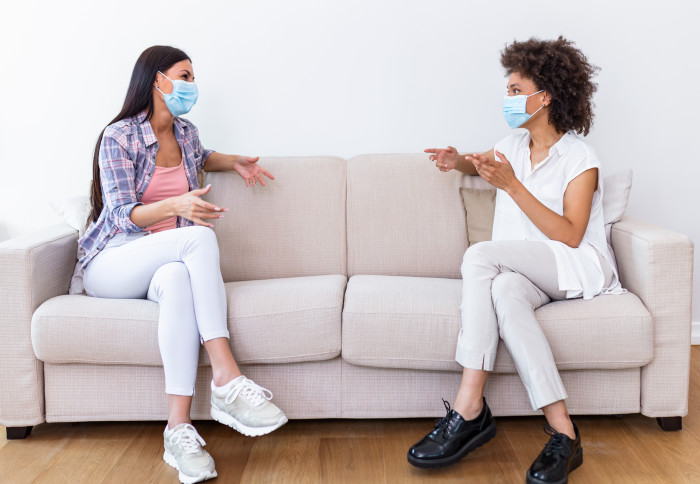Coronavirus more likely to spread inside through maskless talking than coughing

Cambridge and Imperial researchers found that coronavirus is more likely to spread through prolonged talking than coughing in badly ventilated spaces.
The new study, led by the University of Cambridge with Imperial College London researchers, found that in poorly ventilated spaces, the virus behind COVID-19 can spread further than two metres in seconds, and is far more likely to spread through prolonged talking than through coughing.
Typical social distancing rules may not be sufficient when airborne transmission in indoor spaces is considered. Dr Andrea Giusti Department of Mechanical Engineering
The results, reported in Proceedings of the Royal Society A, show that social distancing measures alone do not provide adequate protection from the virus, and further emphasise the vital importance of ventilation and face masks in order to slow the spread of COVID-19.
The researchers used mathematical models to show how SARS-CoV-2 – the virus which causes COVID-19 – spreads in different indoor spaces, depending on the size, occupancy, ventilation and whether masks are being worn. These models are also the basis of a free online tool which helps users understand how ventilation and other measures affect the risk of indoor transmission, and how that risk changes over time.
Co-author Dr Andrea Giusti of Imperial’s Department of Mechanical Engineering said: “The findings and accompanying online tool help to highlight the critical role of ventilation in reducing indoor transmission of coronavirus. The study also highlights that typical social distancing rules may not be sufficient when airborne transmission in indoor spaces is considered.”
The researchers found that when two people are in a poorly ventilated space and neither is wearing a mask, prolonged talking is far more likely to spread the virus than a short cough. When speaking, we exhale small droplets, or aerosols, which spread easily around a room, and accumulate if ventilation is not adequate. In contrast, coughing expels more large droplets, which are more likely to settle on surfaces after they are emitted.
It only takes a matter of seconds for aerosols to spread over two metres
The quick spread of small infectious droplets over several metres in a matter of a few seconds...can happen both indoors and outdoors. Dr Pedro de Oliveira University of Cambridge
when masks are not worn, implying that physical distancing in the absence of ventilation is not sufficient to provide safety for long exposure times. When masks of any kind are worn however, they slow the breath’s momentum and filter a portion of the exhaled droplets, in turn reducing the amount of virus in aerosols that can spread through the space.
The scientific consensus is that the vast majority of COVID-19 cases are spread through indoor transmission – whether via aerosols or droplets. Now that winter has arrived in the northern hemisphere and people are spending more time indoors, there has been a corresponding rise in the number of COVID-19 cases.
First author Dr Pedro de Oliveira of the University of Cambridge said: “In our work we consider the wide range of respiratory droplets humans exhale to demonstrate different scenarios of airborne viral transmission – the first being the quick spread of small infectious droplets over several metres in a matter of a few seconds, which can happen both indoors and outdoors. Then, we show how these small droplets can accumulate in indoor spaces in the long term, and how this can be mitigated with adequate ventilation.”
We hope our models will help people to manage indoor spaces and avoid prolonged lockdown measures. Dr Andrea Giusti Department of Mechanical Engineering
The researchers used mathematical models to calculate the amount of virus contained in exhaled particles, and to determine how these evaporate and settle on surfaces. They also used characteristics of the virus, such as its ability to survive in droplets and amount of virus in infected individuals, to estimate the risk of transmission in an indoor setting due to normal speech or a short cough by an infectious person. For instance, they show that the infection risk after speaking for one hour in a typical lecture room was high, but the risk could be decreased significantly with adequate ventilation.
Dr Giusti said: “We want to use our knowledge of fluid mechanics to help people make better choices. We are looking to further develop our models such that real-time assessment of the infection risk can be made. We hope our models will help people to manage indoor spaces and avoid prolonged lockdown measures.”
The tool
Based on their models, the researchers built Airborne.cam, a free, open-source tool that can be used by those managing public spaces, such as shops, workplaces and classrooms, to determine whether ventilation is adequate. It is designed to helps users understand how mitigation measures like mask wearing affect the indoor transmission of the SARS-CoV-2 virus.
Users can change inputs such as ventilation rate, type of face covering, number of occupants, and type of activity to assess their impact on risk of infection, while more advanced features are available for users who are familiar with the science around aerosol transmission.
The researchers assert that the tool should be used secondary to following government guidelines on hygiene and local or national lockdown measures.
-
This news story was adapted from a press release by the University of Cambridge.
The continuing development of Airborne.cam, which will soon be available for mobile platforms, is supported in part by Cambridge Enterprise and Churchill College.
P. M. de Oliveira et al. ‘Evolution of spray and aerosol from respiratory releases: theoretical estimates for insight on viral transmission.’ Proceedings of the Royal Society A (2021)
Article text (excluding photos or graphics) © Imperial College London.
Photos and graphics subject to third party copyright used with permission or © Imperial College London.
Reporter
Caroline Brogan
Communications Division